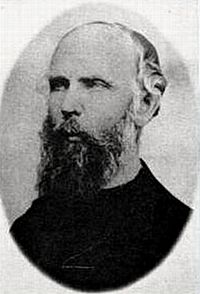William Bishop (politician) facts for kids
Quick facts for kids
William Bishop
|
|
|---|---|

William Bishop
|
|
| State Treasurer of Missouri | |
| In office 1865–1869 |
|
| Personal details | |
| Born | 1817 Martinsburg, Virginia, US |
| Died | May 2, 1879 Kahoka, Missouri |
| Political party | Republican |
| Residences | Clark County, Missouri Alexandria, Missouri |
| Occupation | Real estate seculator commodities broker politician |
| Profession | Army officer |
William Bishop (born 1817 – died May 2, 1879) was an American businessman, military officer, and politician. He lived in the 19th century. He served as the State Treasurer of Missouri from 1865 to 1869.
William Bishop's Life
Early Life and Business
William H. Bishop was born in Martinsburg, Virginia. When he was a child, his family moved to McLean County, Illinois. His father, also named William, was a soldier in the War of 1812.
As an adult, William H. Bishop moved to Clark County, Missouri. By 1846, he had become very successful. He made a lot of money buying and selling land. He also traded in commodities, which are basic goods like crops or metals. By 1860, he owned a lot of property. In March 1861, he went to the first inauguration of Abraham Lincoln. He hoped to get a job in the government.
Serving in the Civil War
When the American Civil War began, William Bishop was living in Alexandria, Missouri. This town was a port on the Mississippi River. In June 1861, a Union General named Nathaniel Lyon asked Bishop for help. He wanted Bishop to organize groups of Missouri Home Guards. These groups would protect the state from pro-Confederate forces and rebel fighters.
Bishop tried to become the leader of the 1st Northeast Missouri Home Guards. However, he lost the election to his friend David Moore. Even so, in July 1861, Bishop started his own group. He organized a cavalry battalion called the "Black Hawk Cavalry." They trained in Warsaw, Illinois.
After training, his unit was stationed in Martinsburg, Audrain County, Missouri. Their job was to protect the Hannibal and St. Joseph Railroad. This railroad was often attacked by Confederate bushwhackers, who were guerrilla fighters. Bishop's unit fought in several small battles across the state.
During his time leading the Black Hawk Cavalry, Bishop faced some challenges. There were political disagreements and problems getting supplies. He also had conflicts with his commanders. Because of this, in February 1862, William Bishop had a military trial. He was accused of serious things, but he was found innocent of all charges. Even though he was cleared, he was removed from command of his unit. The Black Hawks then joined other Union forces to form the 7th Missouri Cavalry Regiment.
Political Career
After the war, William Bishop wanted to improve his reputation. In the spring of 1862, he gathered letters of support. He also took documents from his military trial. He traveled to Washington D.C. There, he met with people to try and get a new military job or a political position. He was not successful.
Bishop returned to Alexandria, Missouri, and went back to his private businesses. Later, he was appointed Provost Marshal and port supervisor. A Provost Marshal was like a military police chief or administrator. He held these jobs until November 1864. That's when he was elected Missouri's 9th State Treasurer. He was a member of the Radical Union Party.
His time as State Treasurer was mostly focused on managing the state's money. He helped secure funds for Missouri's recovery after the Civil War. He also managed to get salary increases for his assistants.
After leaving office in 1869, he mostly lived a quiet life. William Bishop died on May 2, 1879, after having a stroke. He was married to Mary Ann Lapsley in 1849. They had six children. Mary Ann lived for 40 more years after William passed away. William Bishop is buried in Kahoka, Missouri.

